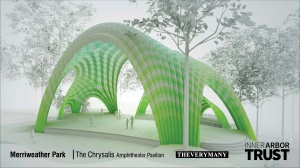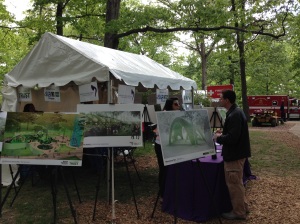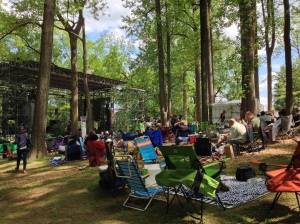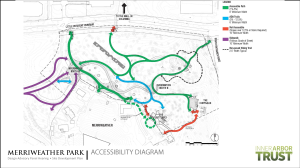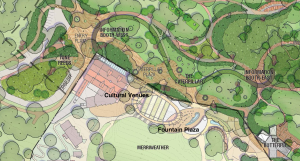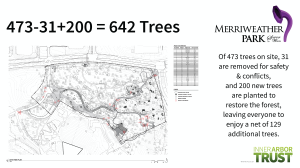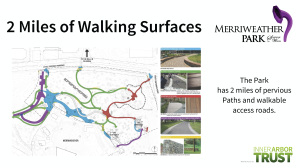tl;dr: I testify in support of the plan for Merriweather Park at Symphony Woods and the Planning Board approves it (note: correlation is not causation), Inner Arbor haters gonna hate, and Brad Canfield of Merriweather shocks me.
I was fortunate enough to be able to attend and testify at the Howard County Planning Board meeting last night at which the Board unanimously approved site development plan SDP-14-073 [PDF] for Merriweather Park at Symphony Woods, the project otherwise known as the Inner Arbor plan. Here’s a lightly-edited copy of my testimony:
Good evening. I’m speaking in support of SDP-14-073. I previously submitted written testimony to the Board; tonight I want to comment some more on the plan.
I did not closely follow the Board’s consideration of the final development plan, but since then I’ve read the documents relating to its decision. I believe the Board made the right call in putting conditions on its approval of that plan. It’s just common sense: We need a park design that works with the natural landscape rather than against it, and one that’s well integrated with Merriweather Post Pavilion.
Almost a year ago I attended the pre-submission meeting for the Inner Arbor plan. At that time I saw a plan that retained elements present in the final development plan but also fully addressed the Board’s conditions. It featured an extensive pathway system that followed the lay of the land and minimized tree removal, an imaginative alternative to the existing Merriweather fence, and attractive and well-sited shared-use structures.
That design, with some refinements, is in the site development plan you’re considering tonight. It’s a very attractive design, a design that’s much better than I would have expected given the previous history of proposed projects for Symphony Woods.
The design in SDP-14-073 incorporates the elements of the final development plan except for the fountain, which the Inner Arbor Trust now proposes be built on the Merriweather property. I understand the reasons for siting the fountain there as part of the Merriweather/Symphony Woods integration. At the same time I understand why this change might disappoint people for whom constructing a fountain was the primary attraction of the original plan for Symphony Woods.
However I believe that the goal of this multi-year effort is not to put a fountain in Symphony Woods. The fountain is simply one part of an overall effort to provide a “unique cultural and community amenity” for downtown Columbia, to quote from the Board’s previous decision. I believe that SDP-14-073 together with the proposed Merriweather Post Pavilion enhancements will meet that goal. The Board challenged CA to meet the conditions associated with its approval of the final development plan, and create a great park for downtown Columbia. The Inner Arbor Trust has more than met that challenge. I strongly urge the Board to approve SDP-14-073. Thank you.
The Planning Board meeting on November 6 saw proponents of the plan slightly outnumbering opponents;1 in comparison, last night’s meeting was a landslide, with 16 people in favor and three people speaking in opposition. Of course this won’t put a rest to the controversy. In an earlier post I compared Inner Arbor opponents to “Obamacare” opponents in their exploitation of the issue as a way to stoke outrage among their base. I don’t expect the Planning Board’s decision will change that dynamic at all. As with the Affordable Care Act, I’m sure the opposition will continue to pursue any and all means to sabotage the development of Merriweather Park at Symphony Woods, with yet more contrived legal arguments (thanks go to Bill Woodcock for highlighting the latest example), complaints about the process, accusations of defiling Jim Rouse’s legacy, and dire warnings of a “disaster of biblical proportions”. (I’m only half kidding about the last one; one person testifying last night used language that was almost that extreme.)
However the analogy to the Affordable Care Act fails in a major way: We’re not talking here about a complicated government program where it’s almost comically easy to raise fear, uncertainty, and doubt among those who haven’t closely followed the issue. It’s a park, with pictures (lots and lots of pictures [187MB PDF]). It’s pretty easy to understand, and you either like it or you don’t. As it happens, all of the members of the general public I’ve talked to (for example, at Wine in the Woods) have liked it a lot. Now that the plan is approved and construction on phase 1 can start, more people will be able to see for themselves what Merriweather Park at Symphony Woods is all about, and I think we’ll find that that experience is repeated.
Finally, before this next phase of the Inner Arbor project begins and Merriweather Park at Symphony Woods starts to take shape, some (I hope) last comments on what went on before. In my year of blogging about the Inner Arbor plan and the associated controversy I have been variously enlightened, delighted, amused, critical, and indignant. However I have never been shocked until last night, while listening to the testimony of Brad Canfield, director of operations at Merriweather Post Pavilion. Assuming I’m correctly recollecting his remarks, in talking about the integration of Merriweather and Symphony Woods he mentioned that Cy Paumier and the original design team had never taken the time to talk to people at Merriweather, except for one phone call a few months after the Columbia Association had rejected the original park design in favor of the Inner Arbor concept.
I quite honestly find that to be mind-boggling. On the one hand you have Merriweather Post Pavilion, the most well-known and best-loved feature of Columbia to the world at large, and a key element in making Howard County an attractive place for businesses and residents. (I believe it was Dick Story who last night noted that while other jurisdictions promoting economic development have universities to help them stand out from the crowd, Howard County has Merriweather.) On the other hand you have Symphony Woods, a largely under-used property whose main function over the past 40+ years has been to serve as a surrounding environment and gateway to Merriweather. If a design team working on a plan for Symphony Woods seemingly doesn’t show any interest whatsoever in working with the Merriweather Post Pavilion operators to figure out ways they could mutually enhance the combination of properties, that speaks volumes to me about that team’s insularity, misplaced priorities, and inability to create a design worthy of what downtown Columbia could become.
Thank goodness there were other people more in touch with the realities of present-day Columbia and Howard County, people who were willing to go out of their way to imagine a better future for Merriweather Post Pavilion and Symphony Woods, and did the work and took the risks to start us on a path to making that future a reality. Thank you, everyone, I’m excited to see where we go from here.
1. The numbers were a bit off because some people nominally listed as opposing the plan didn’t actually speak about the plan itself, but instead complained about various aspects of how the plan came to be (for example, that CA didn’t put the design out to competitive bid).
